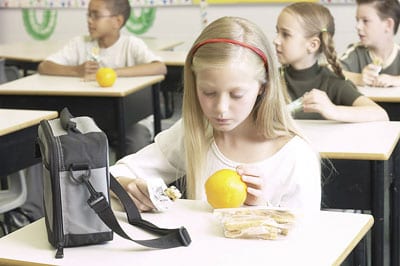While conducting research for my new book, I discovered that parents struggle with how to pack a healthy school lunch that their kids will actually eat! I found that often moms and dads avoid, or give in to whining, temper tantrums or begging, so that school lunch becomes a sugar-stuffed, fat-filled, no-protein meal.
Your child…
Your child may be smiling for the moment, but a school lunch without good quality protein, or one that is too high in fat and sugar, will not give your child the sustained energy he needs to fuel his brain and body throughout the school day for learning and playing. In fact, he may experience a steep drop in energy about an hour after eating a high-sugar meal—making it difficult to focus during afternoon classes or even playtime. In addition, an unhealthy lunch is a sure contributor to weight gain and poor eating habits which can last a lifetime!
Indeed…
Indeed, every child—no matter what her weight—needs to learn how to eat healthy eating and just as importantly, how to stand up to peer pressure (“but, mommmmyyyy, everyone brings cookies and chips”) even when it comes to school lunch. In fact, if you give your child the tools early on to resist peer pressure about lunch box choices, she will be much better equipped to do so when she is older and faced with more serious decisions—like alcohol and drugs.
To begin…
Begin by explaining that lunch must always have a serving of healthy protein such as peanut butter (if your school allows nuts); lean cold cuts, tuna or cheese. Add a serving of a carbohydrate (preferably whole grain–such whole wheat bread or crackers) and always add a fruit and even a vegetable (baby carrots, celery, sliced cucumbers, grape tomatoes, raw cauliflower/broccoli). Last, offer your child a single serving of a ‘junk food’ snack for either lunch or snack. Read the label to determine the serving size of each snack. If your child chooses the ‘junk food’ snack for his lunch box, then pack fruit, veggies, cheese, yogurt, pretzels, or another low-fat, high protein food for snack time. One more important tweak is to replace juice boxes with small bottles of water. For some children, this is a difficult change, so if necessary do so gradually making the substitution for either lunch or snack until she gets used to it.
Getting them involved…
You may experience some resistance to these changes, but don’t give in! Remember, your child’s health is very important, as is teaching him that just because other people make less healthy choices, it doesn’t make them correct! You will find that involving your child in preparing school lunch will make her much more invested in eating it. Preschool and young elementary children can help by putting in the prepared items (water, snacks). Older kids can make their own sandwiches and eventually make the entire lunch without supervision. This level of independence should be encouraged, and each healthy choice applauded. Don’t be surprised if you find that your child’s new knowledge starts to spill over to other areas of eating and food preparation. Before long you will have the healthiest kid on the block!
About the Author
Dr. Susan Bartell is America’s #1 Family Psychologist. Her latest book Dr. Susan’s Fit and Fun Family Action Plan is now available. You can learn more about Dr. Bartell’s work at www.drsusanbartell.com





